More new boat pix!! and the Keel!!
28/07/07 13:25 Filed in: Shoal draft
The New Boat and her keel!!
Here are some images from the Northshore yard in Itchenor. The new boat has just arrived from the moulding shop and is ready to be fitted out. There are also some pictures here of her lifting keel as that will be one of the first projects - to fit the keel in place. I though this would be a good time to look at the keel system in general since the keel and the Southerly's shallow draft abilities are a big part of the reason we chose her for our next boat!
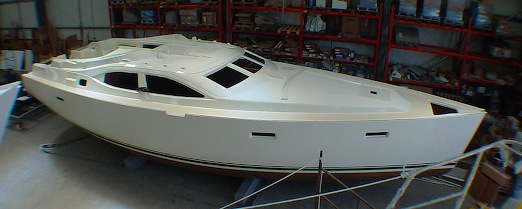
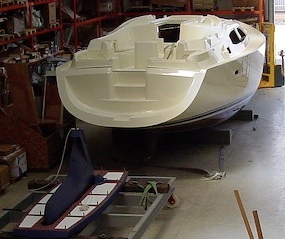 Keel System
Keel System
Here the keel is prepped and ready to go into the boat. The keel system consists of a massive grounding plate that bolts into the bottom of the boat. This plate weighs 2100Kg (4600 pounds) which is quite a bit more than our car. In the picture you can see the swinging keel itself in the raised position. It weighs another 1570Kg (3500 pounds) which is about the weight of a BMW 525. So when you swing the keel down you are basically hanging the weight of a respectable car down for added performance. With 9 foot draft this boat sails well to windward! Its one of the advantages of a swinging keel that the designer could go as low as he wanted for good performance.
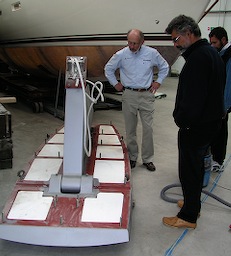 Here is a shot of the keel close up. This is a massively strong system that Northshore have refined since they started building swing-keel boats more than 20 years ago. You can see the widely spaced bolt pattern that connects the keel to the reinforced inset in the hull. One thing I specially like about the builder is their British engineering! Good and solid!
Here is a shot of the keel close up. This is a massively strong system that Northshore have refined since they started building swing-keel boats more than 20 years ago. You can see the widely spaced bolt pattern that connects the keel to the reinforced inset in the hull. One thing I specially like about the builder is their British engineering! Good and solid!
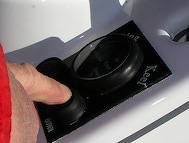 Raising and lowering the keel is done by a hydraulic system. There is an electric pump that runs the hydraulic system and it is remotely controlled from the helm. Just above the buttons is a series of LEDs that show how high the keel is. There is also an emergency handle to be used in case the electric system fails.
Raising and lowering the keel is done by a hydraulic system. There is an electric pump that runs the hydraulic system and it is remotely controlled from the helm. Just above the buttons is a series of LEDs that show how high the keel is. There is also an emergency handle to be used in case the electric system fails.
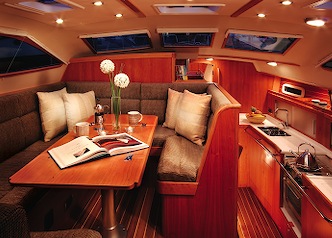 Boat Design for a Swing Keel
Boat Design for a Swing Keel
One of the toughest aspect of designing a good swinging or lifting keel boat is what to do with the keel when it comes up! It has to go somewhere and many designers have had trouble with this. We have been on lifting keel boats where the keel case divides the whole saloon. Very inconvenient. But Northshore have come up with an ingenious design for the 42 that hides the keel just under the starboard side of the raised saloon. The raised saloon has great views while sitting there, and I doubt anyone coming on board at the boat show would even guess there was a keel the weight of a BMW retracted under their seat. Here is a picture of the saloon - the keel retracts under the seat on the centreline of the boat. Very clever design.
Why go to all this bother?
Well this image of a Bahamas Bank says it all. There are so many unspoiled anchorages we will be able to get to with a shallow keel - and the Bahamas is arguably the finest cruising ground within easy reach of North American East Coast sailors. We have sailed there 4 different cruises and have fallen in love with the place. There are whole island groups that are hard to visit with a deep draft yacht. We are going back with the Southerly!! (see below)
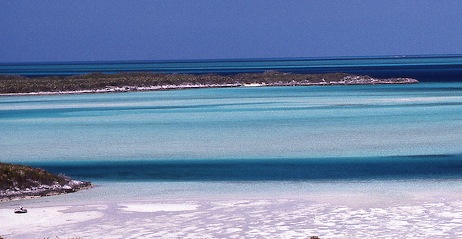
Shallow Draft
Many places in the world are easy to navigate if you have a shallower boat. The Trent-Severn Waterway in Canada is limited to 5 feet. Ditto the Midi Canal in France. Many places in the US Intra-Coastal Waterway are shoaling up around the inlets. Boats that draw more than 5 feet are deeper than the average so dredging often doesn't occur until that number is reached and the problem starts to affect the majority of boats.
But there is more to shallow draft cruising. Some powerboats draw just 3-4 feet but can't afford to run aground! By this I mean they have props hanging down being the lowest point. So if they hit it is likely expensive. With Two-Step we could often poke slowly into places that were just 6 feet deep since when we touched the bottom it didn't matter. Just our keel would touch and we would then reverse off again. The new boat is the best of both worlds - it draws just 3 feet but can also afford to run aground since it has the heavy keel and a grounding plate, and it protects its prop with a skeg. We will be able to poke slowly into really shallow spots.
Of course we wouldn't want to have the ability to get to shallow places and still not feel safe crossing oceans. The Southerly can do that too. Many have crossed oceans, and we are looking forward to a nice quick transatlantic passage this fall - en route to the Caribbean.
Shoal Draft Anchorages
The final advantage for the Southerly keel is the ability to dry out. It is actually one of the main reasons for the design. In the South of England and the north West of France there are many tidal anchorages. This would be a place that would be a good anchorage at high tide but would have no water at low tide. So the only kind of boat that can anchor there would need to be able to rest down on the bottom at low tide. In Two-Step we would have not been able to anchor there since the keel would cause the boat to heel further and further as the tide went down. We would finally be lying on our side. Most uncomfortable and possibly even at risk of flooding as the water came back in. With the new boat this is the perfect anchorage. And again, the Bahamas has many places like this. Comparing to Two-Step, I would imagine there are as many as double the Bahamian anchorages available for the Southerly as for Two-Step. Similar in the Chesapeake and Atlantic France.
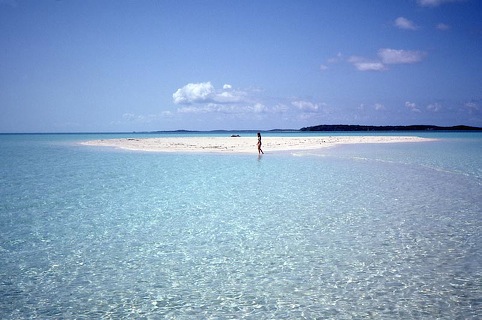
Here are some images from the Northshore yard in Itchenor. The new boat has just arrived from the moulding shop and is ready to be fitted out. There are also some pictures here of her lifting keel as that will be one of the first projects - to fit the keel in place. I though this would be a good time to look at the keel system in general since the keel and the Southerly's shallow draft abilities are a big part of the reason we chose her for our next boat!

 Keel System
Keel SystemHere the keel is prepped and ready to go into the boat. The keel system consists of a massive grounding plate that bolts into the bottom of the boat. This plate weighs 2100Kg (4600 pounds) which is quite a bit more than our car. In the picture you can see the swinging keel itself in the raised position. It weighs another 1570Kg (3500 pounds) which is about the weight of a BMW 525. So when you swing the keel down you are basically hanging the weight of a respectable car down for added performance. With 9 foot draft this boat sails well to windward! Its one of the advantages of a swinging keel that the designer could go as low as he wanted for good performance.



One of the toughest aspect of designing a good swinging or lifting keel boat is what to do with the keel when it comes up! It has to go somewhere and many designers have had trouble with this. We have been on lifting keel boats where the keel case divides the whole saloon. Very inconvenient. But Northshore have come up with an ingenious design for the 42 that hides the keel just under the starboard side of the raised saloon. The raised saloon has great views while sitting there, and I doubt anyone coming on board at the boat show would even guess there was a keel the weight of a BMW retracted under their seat. Here is a picture of the saloon - the keel retracts under the seat on the centreline of the boat. Very clever design.
Why go to all this bother?
Well this image of a Bahamas Bank says it all. There are so many unspoiled anchorages we will be able to get to with a shallow keel - and the Bahamas is arguably the finest cruising ground within easy reach of North American East Coast sailors. We have sailed there 4 different cruises and have fallen in love with the place. There are whole island groups that are hard to visit with a deep draft yacht. We are going back with the Southerly!! (see below)

Shallow Draft
Many places in the world are easy to navigate if you have a shallower boat. The Trent-Severn Waterway in Canada is limited to 5 feet. Ditto the Midi Canal in France. Many places in the US Intra-Coastal Waterway are shoaling up around the inlets. Boats that draw more than 5 feet are deeper than the average so dredging often doesn't occur until that number is reached and the problem starts to affect the majority of boats.
But there is more to shallow draft cruising. Some powerboats draw just 3-4 feet but can't afford to run aground! By this I mean they have props hanging down being the lowest point. So if they hit it is likely expensive. With Two-Step we could often poke slowly into places that were just 6 feet deep since when we touched the bottom it didn't matter. Just our keel would touch and we would then reverse off again. The new boat is the best of both worlds - it draws just 3 feet but can also afford to run aground since it has the heavy keel and a grounding plate, and it protects its prop with a skeg. We will be able to poke slowly into really shallow spots.
Of course we wouldn't want to have the ability to get to shallow places and still not feel safe crossing oceans. The Southerly can do that too. Many have crossed oceans, and we are looking forward to a nice quick transatlantic passage this fall - en route to the Caribbean.
Shoal Draft Anchorages
The final advantage for the Southerly keel is the ability to dry out. It is actually one of the main reasons for the design. In the South of England and the north West of France there are many tidal anchorages. This would be a place that would be a good anchorage at high tide but would have no water at low tide. So the only kind of boat that can anchor there would need to be able to rest down on the bottom at low tide. In Two-Step we would have not been able to anchor there since the keel would cause the boat to heel further and further as the tide went down. We would finally be lying on our side. Most uncomfortable and possibly even at risk of flooding as the water came back in. With the new boat this is the perfect anchorage. And again, the Bahamas has many places like this. Comparing to Two-Step, I would imagine there are as many as double the Bahamian anchorages available for the Southerly as for Two-Step. Similar in the Chesapeake and Atlantic France.

blog comments powered by Disqus